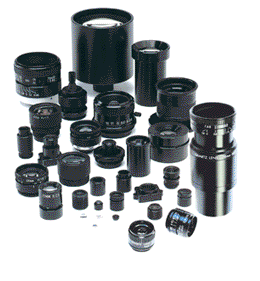High resolution lenses for machine vision — standard and custom lens design
Universe Designs Band-Pass Filters
High Resolution Lenses for machine vision, instrumentation, inspection and vibration-sensitive applications. Standard and custom hi-res lens assemblies.

Band-Pass Filters
A device that is designed to accept a signal but that only allows for certain frequencies within that signal to pass through, and blocks all other frequencies, is called a band-pass filter. These filters are either electronic or optical. Electronic band-pass filters are used in radio and audio equipment and myriad other circuit types. Optical band-pass filters are designed to allow only specified colors (wavelengths) of light to pass through the device.
Band-pass filters are constructed with a two filter system: a high pass filter that allows frequencies above a specified threshold and a low pass filter that allows specified frequencies to pass through.
Audio filters are designed to allow frequencies of between 20 and 20,000 hertz to pass through, that level is within the typical hearing range of the human ear. To accomplish this, a filter with a 20,000-hertz low pass filter would be fitted with a 20-hertz high pass filter.
Devices equipped with electronic band-pass filters can be installed into an integrated circuit (IC) chip or can be designed with capacitors, inductors or resistors; capacitors are typically the preferred design methodology. Manipulating the resistance values of the resistors and the capacitance rating of the installed capacitors allows for the effective area of the filter to be changed.
There are many filters that are equipped with variable resistors that allow the effective area to be changed by the user and this eliminates the need for a complete rebuild to address varying pass-through frequencies.
Band-pass filter designers find the challenge is that the typical band-pass filter has a graduated effect; this means a filter will not necessarily eliminate all the frequencies that fall below the 20 hertz or above the 20,000-hertz levels. The frequencies are reduced but the graduated effect of the filter can be modified by filter designers for use in more complicated structures.
The way a band-pass filter is used in the optical realm is that, rather than letting sound frequencies and signals through, the optical band-pass filter allows for specified wavelengths of light to pass through. The most common use of the optical band-pass filters is in red-blue 3D glasses. The blue lens of the glasses allows blue bands of lights to pass while the red lens allows for red bands of light. In astronomy, the band-pass filters are used by astronomers when they are viewing ultraviolet or infrared light that is being emitted by distant galaxies or stars.